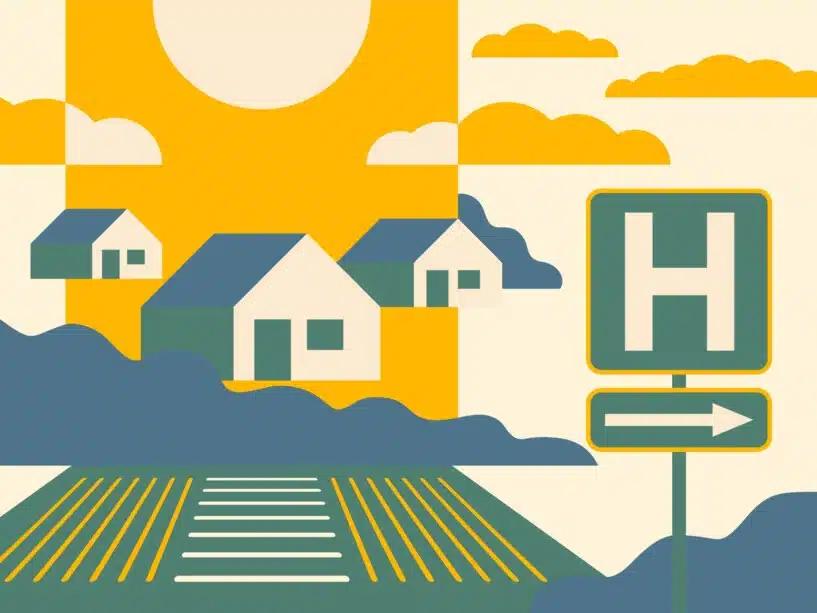3 Things Rural Healthcare Consumers Wish Large Hospital Systems Knew About Them

Rural healthcare is on life support. Whether due to a shortage of healthcare workers, prohibitively high costs or the consolidation of services, delivering care to patients where they are and when they need it is a constantly evolving challenge outside major metro areas. Large hospital systems are often the last remaining option for rural consumers, but simply exporting urban healthcare delivery doesn’t always work.
Read on to learn what unique challenges rural healthcare consumers face and how large hospital systems can use content and communications to help overcome them.
The State of Rural Healthcare
Facing hospital closures, a lack of financial resources, and provider shortages, rural areas are in critical condition when it comes to limited access to care. The crisis is leaving millions of people nationwide, who already face health disparities, at increased risk for life-threatening conditions.
1. Access to Rural Healthcare Is Limited
With hospital closures and low rates of specialty providers in remote areas, consumers in rural areas often have to travel long distances for care, especially specialty care. Transportation can be a prohibitive obstacle for rural consumers, leaving many without options.
While telehealth has emerged in recent years as a remarkable solution, many consumers are not comfortable or familiar with using online health tools. Others may have limited broadband or poor connectivity.
All these factors have combined to significantly limit the healthcare options available to rural consumers.
How Hospitals and Health Systems Can Respond
To increase access to telemedicine, hospital systems can improve and expand upon the efforts around telehealth services. To overcome user trepidation, consider publishing telehealth guides and step-by-step usage resources, making it less intimidating and more accessible to patients who have not used such services. Create user-friendly mobile apps to assist patients with virtual waiting rooms, provide access to patient portals with patients’ health information, and send reminders about preventive care and upcoming appointments.
To make a more significant and guided effort, some systems have set up telehealth outposts—brick-and-mortar clinics with providers on staff who not only treat patients but also connect them via telehealth to specialists in other areas of the country during their visit. Patients receive the in-person support and guidance they need in an accessible clinical setting while getting access to the expertise they require for complicated conditions that would otherwise be out of reach.
2. Rural Populations Experience Health Disparities
Due to lower income levels and limited community resources, rural populations often have less access to healthy foods, higher rates of smoking and addiction, and higher exposure to environmental hazards than other populations. What’s more, many patients living in rural areas lack access to adequate health education resources, which can contribute to a lack of understanding about preventive care and chronic disease management. The social determinants of health (a term that encompasses factors such as a person’s living conditions, access to healthcare and financial stability) experienced by this population put them at higher risk for conditions like cancer, stroke and heart disease.
How Hospitals and Health Systems Can Respond
Patient education and engagement are critical factors in combatting these disparities and improving healthcare outcomes in rural areas. Hospital systems can help close the communication gap to promote health equity with efforts like translating content for multilingual audiences and producing educational materials with messaging that is empowering — and never shaming.
Positive messaging can include resources for living a healthy lifestyle, such as healthy recipes, strategies for quitting smoking and substance abuse resources. Connect consumers to content about preventive health and meet them where they are, like on social media channels.
Raising awareness of health risks through health risk assessments and screening campaigns is another way to increase patient education with to improve rural healthcare. Employ these strategies when creating communication with social determinants of health in mind.
3. Financial Hardships Can Be a Barrier to Care
Rural healthcare consumers are more likely to have financial barriers and less likely to be insured, so concerns about out-of-pocket expenses are disproportionately high in rural areas. Because preventive medicine is less expensive than curative healthcare, promoting prevention is key.
How Hospitals and Health Systems Can Respond
Health systems can employ 1:1 marketing techniques to help rural consumers become aware of their risks based on demographics and medical history so they can help prevent chronic illness and better manage chronic conditions to avoid costly complications. Create communication around scheduling annual physicals and screenings, such as mammograms and colonoscopies. These efforts can increase rates of illness-prevention and early detection, lowering an individual’s overall health costs over time.
Use these campaigns to educate patients about their conditions, so they can make more informed decisions about their healthcare and healthy habits, reducing their need for additional healthcare expenses.
Want to Understand Your Rural Healthcare Consumers?
Go straight to the source with a reader survey. Reader surveys can tell you what your audience is interested in and how they want to receive information. Fill out the form below to download our survey template.

